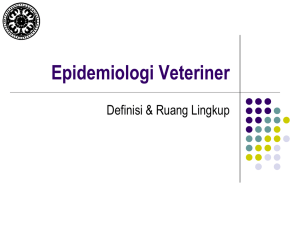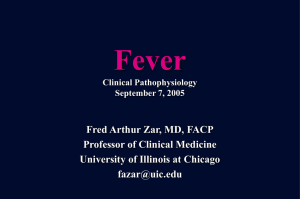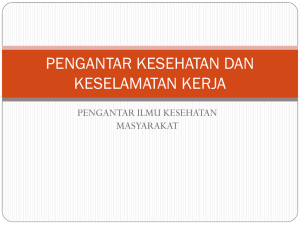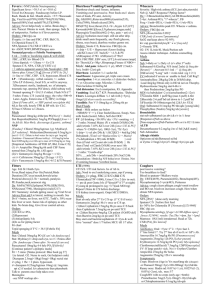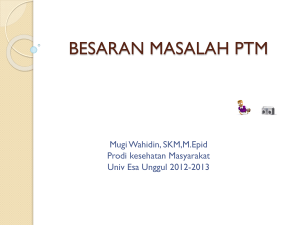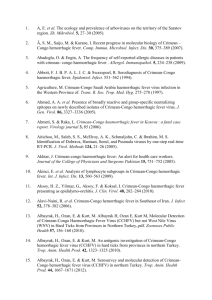Pengantar Ilmu Kesehatan Masyarakat 2
advertisement
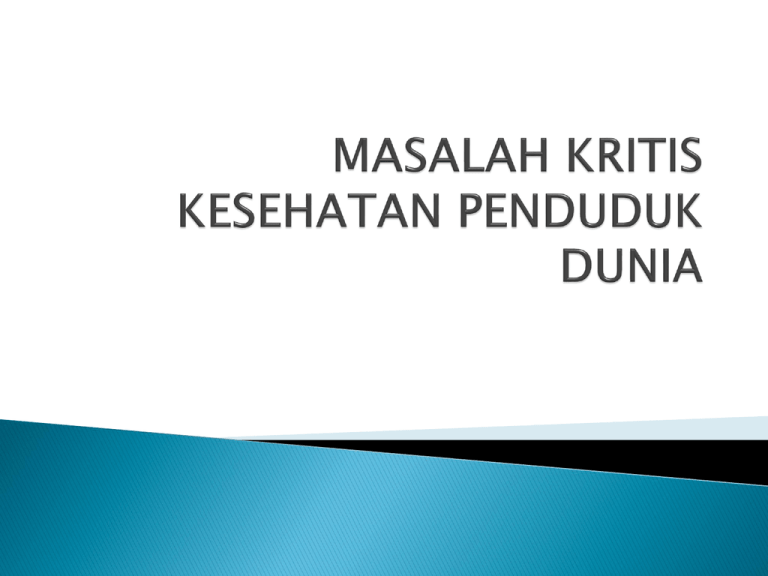
Definisi Kecenderungan Global Masalah Kesehatan Masyarakat Program Kesehatan di Negara Maju dan Berkembang MDG’s 2015 A set of global processes that are changing the nature of human interaction across a wide range of social spheres including the economic, political, cultural and environmental. One framework for understanding globalization is to focus on three dimensions of global change: spatial, temporal and cognitive Global health is derived from public health and international health, which, in turn, evolved from hygiene and tropical medicine Global health can be thought of as a notion (the current state of global health), an objective (a world of healthy people, a condition of global health), or a mix of scholarship, research, and practice (with many questions, issues, skills, and competencies). There are many working definitions of global health. Some emphasize certain types of health problems (e.g., communicable diseases), whereas others emphasize certain populations of interest (e.g., the poor), focus on a geographic area (e.g., the Global South), or have a specific mission (e.g., equity). Global health should be defined by two key elements: its level of analysis, which involves the entire population of the world, and the relationships of interdependence that bind together the units of social organization that make up the global population (e.g., nation states, private organizations, ethnic groups, and civil society movements). The Global Health Education Consortium defines international health as a subspecialty that “relates more to health practices, policies and systems...and stresses more the differences between countries than their commonalities” “the application of the principles of public health to problems and challenges that affect low and middle-income countries and to the complex array of global and local forces that influence them” (Merson, Black, and Mills, 2006). Global health has areas of overlap with the more established disciplines of public health and international health (table). All three entities share the following characteristics: priority on a population-based and preventive focus; concentration on poorer, vulnerable, and underserved populations; multidisciplinary and interdisciplinary approaches; emphasis on health as a public good and the importance of systems and structures; and the participation of several stakeholders 1. PERGESERAN/TRANSISI BESAR-BESARAN KESEHATAN PENDUDUK DUNIA SEDANG TERJADI. 2. TANTANGAN YANG DIHADIRI PARA MASYARAKAT KIAN BERTAMBAH LUAS. AHLI KES. 3. AGENDA MEMERANGI PENYAKIT-PENYAKIT MENULAR BELUM SELESAI, MASALAH BARU YANG BERSIFAT ENDEMIK BELUM TERSELESAIKAN TIMBUL MASALAH BARU YANG BERUPA PANDEMIK MULAI MENGANCAM. 11 a. b. c. d. e. f. g. h. Communicable : - Malaria, tuberculosis, polio, measles, small pox Pandemic Diseases : - SARS, DENGUE. HIV/AIDS. AVIAN & SWINE FLU Non Communicable Diseases (NCD) : - CVD : Hypertension, Diabetics, abesity, mental health Global Environmental Changes : - Climate Changes : bad weather, global warming hurricane, cyclone Natural and man-made disasters. Life Style and addictive diseases : Tobacco, Narcotics, drugs abuse Violence : TERRORISM and Bioterrorism Traffic Accidents 12 Klasifikasi Risiko Kesehatan Global Ideoscapes Berbagai luaran dari ideologi yang dipercayai. Misal neoliberalisme mempertajam kesenjangan & kemiskinan. Termasuk kesehatan & terorisme Technoscapes Penggunaan teknologi dengan segala resikonya, termasuk dependensi, limbah teknologi & Efek Gas Rumah Kaca (GRK) Ethnoscapes Arus migrasi dengan segala akibatnya termasuk kesehatan Mediascapes Syiar/promosi yang gencar termasuk “Communicated Disease” Finanscapes Arus kapital yang pengaruhi berbagai aspek kehidupan sosial ekonomi, termasuk kes EnvironScapes Bencana alam Modifikasi dari: A. Appadurai, New School University, PANDEMI Lebih dari 1100 epidemik terjadi dalam 5 th terakhir Sejak dekade 70an, ≥1 penyakit baru teridentifikasi setiap tahunnya Lebih dari 40 penyakit baru, tidak pernah diketahui pada 20thn yl Kecepatan bertumbuh (emerging) semakin cepat & luas dlm dekade terakhir Wabah dan epidemi di suatu tempat hanya berbeda sdkt waktunya dengan tempat lain Penyakit (Relatif) Baru Dalam 20tahun Terakhir1 Acanthamebiasis AIDS Anthrax Antimicrobial and insecticide resistance Australian Bat Lyssavirus Babesiosis Bartonella henselae Botulism Campylobacteriosis Penyakit (Relatif) Baru Dalam 20tahun Terakhir2 Chikungunya Cryptosporidiosis Cyclosporiasis Prion Disease, Creutzfeldt-Jacob (vCJD) Ebola Hemorrhagic Fever Encephalitozoon cuniculi Encephalitozoon hellem Enterocytozoon bieneusi Ehrlichia chafeensis Ehrlichiosis Penyakit (Relatif) Baru Dalam 20tahun Terakhir3 Escherichia coli 0157:H7 Enterovirus 71 Guanarito Virus Hantaan Hemorrhagic Fever with Renal Syndrome (HFRS) Hantavirus Pulmonary Syndrome Helicobacter pylori Hendra Virus Hepatitis C Penyakit (Relatif) Baru Dalam 20tahun Terakhir4 Hepatitis E HIV Human herpesvirus 6 (HHV-6) Human herpesvirus 8 (HHV-8) Human Monkeypox Influenza, H5N1 Lassa Fever Legionnaires Disease Lyme Borreliosis Penyakit (Relatif) Baru Dalam 20tahun Terakhir5 Sabia Virus SARS Coronavirus Sindbis Sin Nombre Virus Staphylococcal Infection, MethicillinResistant, Vancomycin-Resistant Streptococcal Infection (toxic shock syndrome, necrotizing fasciitis, etc.) Tuberculosis (MDR-TB, XDR-TB) Tularemia Malaria, Drug-Resistant Penyakit (Relatif) Baru Dalam 20tahun Terakhir6 Marburg Hemorrhagic Fever Monkeypox, Human Nipah Virus O’nyong’nyong Fever Oropuche Fever Parvovirus B-19 Plague Rift Valley Fever Rotavirus West Nile Encephalitis Whitewater Arroyo Virus AS Fauci SAFETY-PANDEMIC & BIOTERORISME Dampak Ekonomi SARS, Cina, HK, Kanada $30-50M $40M $30M $20M $10M PERKIRAAN KERUGIAN $50M Peny Mulut & Kuku UK $25-30M BSE, UK $10-13M Avian Flu, Asia $8-12 M Swine Fever, Nl, $2-3M 1990 91 92 93 BSE, Jap $1.5 M FMD, Taiwan $5-8M Nipah, May $350-400M 94 95 96 Avian Flu, NL $500Jt HPAI, Italy $400Jt 97 98 99 00 01 02 BSE, US $3-5 M BSE, Can $1.5M 03 04 05 2006 Source: Bio Economic Research Associates Trend of Confirmed Cases of Malaria 2000-2006 3.50 3.14 3.00 2.85 2.67 2.50 2.00 1.42 1.50 1.47 1.31 1.00 0.98 0.50 0.00 2000 2001 2002 2003 2004 2005 2006 Depkes, 2006 24 LAPORAN IPCC United Nation Intergovernmental Panel on Climate Change (IPCC) : • Bukti – bukti menunjukkan peningkatan suhu dibumi (Global Warming) Sejak dekade 50 an : Suhu permukaan bumi meningkat 0,6°C Pegunungan bersalju mencair & wilayah es berkurang • Perkiraan moderat pada 2100 : Rata – rata suhu meningkat 3°C Peningkatan permukaan laut setinggi 45cm 25 1998 • Hurricane Mitch menyebabkan banjir di Central America • Meningkatnya insidensi malaria, dengue, cholera & leptospirosis 1999 • Cyclone Orissa menyebabkan kematian 10,000 & 10 -1 5 juta jiwa menderita • Banjir di Caracas, Venezuela menyebabkan kematian 30,000 jiwa 2000 • Hujan dan Badai di Mozambique, meningkatkan insidensi malaria 5 kali 2003 • Suhu musim panas di Eropa yang meningkat, menyebabkan : Peningkatan kematian 27.000 jiwa, Kebakaran hutan yang luas, Melumernya pegunungan Alpian seluas 10% 26 Penyebaran penyakit semakin meluas akibat pemanasan global dan cuaca yang berfluktuasi ekstrim Suhu menyebabkan pertumbuhan mikroba dan vektor penyakit, yang lebih meluas dan meningkatkan ketahanan hidupnya Iklim berkolerasi dengan intensitas dan waktu terjadinya wabah (McMichael et al, 2003) 27 DBD adalah salah satu penyakit virus yang terpenting di dunia, termasuk di Indonesia. Saat ini tidak ada vaksin dan tidak ada juga pengobatannya (kecuali pengobatan pendukung saja) Penyebarannya di dunia terkait dengan : • Suhu dan kelembaban udara Bagaimana proyeksi pertumbuhan DBD di Indonesia? Bersama HIV/AIDS, TBC Prioritas Dunia dapat bantuan dana International. 28 The Paradox of Globalization vs. Localization “The World is Flat” “ The World is Still Round” Thomas L. Friedman Robert J. Samuelson New York Times columnist Newsweek columnist 29 Each year, the tobacco industry spends billions of dollars on advertising, marketing and promotion. In the United States alone, where less than 5 percent of the world’s smokers live, tobacco companies spent over $8.2 billion on advertising and promotion in 1999. “The media like the money they make from our advertisements, and they are on ally that we can and should exploit.” -- Philip Morris” 30 The tobacco companies pay internationally known musicians popular with young people to perform in target markets. By blanketing these countries with promotional materials for the concerts, the companies gain an invaluable link in the minds of young people between their heroes and the companies’ cigarette brands. 31 Tobacco companies are now moving beyond traditional promotional items to the marketing of other products with shared brand name, such as Marlboro Classics clothing and Camel Active Wear. These now marketing ventures are designed to keep promoting tobacco brand names even when direct tobacco advertising is banned. Putting their logos on t-shirt, hats, backpacks and other consumer items popular with children helps circumvent advertising restrictions and turn the wearers into walking billboards. 32 Tobacco companies sponsor youth–oriented contests which often require the purchase of cigarettes in order to enter. They also sponsor adventure holidays, which not only help them circumvent advertising bans but help link smoking with outdoor adventure and fun. “If younger adults turn away from smoking, the industry must decline, just as a population which does not give birth will eventually dwindle” --R.J. Raynolds. 33 “We’re in the cigarette business. We’re not in the sports business. We use sports as an avenue for advertising our products… We can go into an area where we’re marketing an event, measure sales during the event and measure sales after the event, and see an increase in sales.” -- R.J. Raynolds’ 34 In many countries, cigarette advertising on billboards is ubiquitous, dominating the visual landscape. “Point of sale” advertising is displayed in stores and other venues that sell cigarettes, usually at childrens’ eye level. Cigarette companies supply vendors with promotional materials including posters and display cases and in effect turn the stores into giant cigarette advertisements. 35 Smoking prevalence 70% 64% 58% 60% 50% 42% 40% 30% 21% 20% 10% 0% Illiterate <6 years 6-12 years >12 years Length of schooling 36 Jika keluarga miskin berhenti merokok, maka anak – anak gizi buruk akan berkurang 11,5 juta (Effroymson, 2004) Berbagai media di Indonesia memperlihatkan anak – anak menderita gizi buruk tetapi kepala keluarga tetap lebih mementingkan merokok daripada gizi anak – anaknya. 37 KECIL SEKALI DALAM MENAHAN ARUS COMMUNIVATED DISEASE INI : • Belum ikut ratifikasi FCTC • Tidak ada pengendalian sistematik penjualan rokok terhadap anakremaja • Tidak ada pengendalian sistematik dlm “communicated disease” ini dengan regulasi media – komunikasi yang efektif PENGABAIAN HAK-HAK W.N OLEH PEMERINTAH 38 Menkes: Indonesia Akan Jadi Tempat Sampah Rokok Kementerian Perindustrian, Perdagangan, Tenaga Kerja dan Transmigrasi masih keberaratan terhadap eksesi FCTC (Framework Convention on Tobacco Control) karena FCTC milik asing dan bisa mengancam 6 juta pekerja (Faktanya hanya 900.000 yang menjadi pekerja langsung. Sisanya merupakan petani tembakau dan cengkeh. Padahal kata Menkes, Indonesia salah satu negara yang paling aktif dalam perumusan dan pembahasan draft FCTC. Myanmar 9% Philippines 10% Thailand 19% Malaysia 4% Vietnam 11% Indonesia 47% Total produksi tembakau dunia: 7juta metrik ton (2006) Asean: 392rb metric ton (6% produk dunia) Indonesia mengisi lk 3% produk dunia (Tobacco atlas , 2009) Diperkirakan 46% dari total perokok di ASEAN Diperkirakan 4,8% dari total perokok di dunia (WHO, Report on Global Tobacco Epidemic,2008) 1200 1000 800 600 400 200 0 (Tobacco atlas , 2009) % Smoking Prevalence 45 40 35 30 25 20 15 10 5 0 ASEAN Countries (SEATCA, 2008) Indonesia 66.8 Malaysia 59 Philippi… 56.4 Vietnam 55.3 Thailand 47.8 Cambodia 47 Lao PDR Singapore Myanmar 42.9 35.1 34 Seconhand Smoke adalah resiko kematian tertinggi pada indoor air pollution (SEATCA, 2008) % Smoking Prevalence 45 40 35 30 25 20 15 10 5 0 ASEAN Countries (SEATCA, 2008) Riset di 23 negara dengan sampel 20.000 subyek dengan status ekonomi rendah memperlihatkan bahwa jatuh sakit mendorong proses pemiskinan dengan menghebat Kaum papa akses membeli rokok terkait dengan ◦ Harga murah ◦ Iklan ◦ Counter rokok yg mudah dijangkau Meningkatnya • faktor resiko personal & lingkungan • malnutrisi Kesakitan akibat Rokok Menurunnya: • kualitas hidup • produktivitas • kemampuan belajar • tabungan Menurunnya : • akses ke pengetahuan & informasi • kemampuan mengakses pelayanan Meningkatnya hutang, dll Kemiskinan Verifikasi empiris dlm disertasi Sirait, 20 PARADIGMA SAKIT • PELAYANAN KURATIFREHABILITATIF • HEALTH SERVICE MODEL • HEALTH PROGRAM FOR SURVIVAL • PROGRAM KESEHATAN MENCEGAH KEMATIAN 1945 PARADIGMA SEHAT PARADIGMA HUMAN DEVELOPMENT • 1 MARET 1999 • PARADIGMA SEHAT • MEMBERI KESADARAN KEMAUAN DAN KEMAMPUAN UNTUK HIDUP SEHAT • BANYAK YANG BERPENDAPAT PARADIGMA SEHAT SEBELUM DILAKSANAKAN DI INDONESIA • SERUAN AKSI NASIONAL MENINGKATKAN DERAJAT KESEHATAN MASYARAKAT DALAM RANGKA PEMBANGUNAN MANUSIA INDONESIA • KEBIJAKAN MENKOKESRA 1999 2006 SEKARANG 48 PARADIGMA SAKIT • PELAYANAN KURATIFREHABILITATIF • HEALTH SERVICE MODEL • HEALTH PROGRAM FOR SURVIVAL PARADIGMA SEHAT PARADIGMA HUMAN DEVELOPMENT • HEALTH GAIN APPROACH • PEOPLE’S HEALTH EMPOWERMENT • COMBATING HEALTH RISKS • PROMOTIF, PREVENTIVE, PROTECTIVE • PENINGKATAN DAN PEROLEHAN NILAI SEHAT • MEMBANGUN MANUSIA ATAU SDM YANG BERKUALITAS • MEMBANGUN GENERASI YANG AKAN DATANG • HUMAN DEVELOPMENT • SUSTAINABLE DEVELOPMENT OF MANKIND 1970 1990 SEKARANG 49 1990 → KONSEP “SUSTAINABLE DEVELOPMENT” NEGARA MAJU : “HUMAN SUSTAINABLE” DEVELOPMENT : “SUSTAINABLE DEVELOPMENT OF MANKIND” GENERASI YANG AKAN DATANG HARUS LEBIH BAIK DARI GENERASI SEKARANG PEMAHAMAN BAHWA PENDUDUK SEBAGAI ASET NEGARA TERPENTING PEMBANGUNAN GENERASI YANG AKAN DATANG HARUS MENJADI PERHATIAN SEMUA NEGARA DI DUNIA SEBAGAI BAGIAN DARI SUSTAINABLE DEVELOPMENT OF MANKIND 50 Sehat Belum Dilihat Sebagai Unsur Penting Pembangunan Sehat Belum Tersedia Alokasi Dana Di Uud45 Maupun UU - Kesehatan No. 23/1992 Berapa alokasi untuk bidang kesehatan ?? Sehat Belum Ada Bab Tersendiri Dalam UUD-1945 Di Banyak Kabupaten/Kota Kesehatan Prioritas Rendah Pemda Yang Tidak Menyediakan Dana Kesehatan Tidak Melanggar Konstitusi Pembangunan Generasi Yang Akan Datang Belum Ada Dalam UUD-45 1. 2. 3. PROGRAM INVESTASI DINI UNTUK MEMBANGUN GENERASI YANG AKAN DATANG SEHAT DAN CERDAS MELAKUKAN UPAYA PROMOTIF, PREVENTIF, PROTEKTIF BAGI PENDUDUK USIA PRODUKTIF UNTUK MENINGKATKAN MELIHAT KEADAAN SEHAT PRODUKTIF UNTUK KELANGSUNGAN PEMBANGUNAN NEGARA MENYEDIAKAN PELAYANAN PENGOBATAN YANG BERKUALITAS BAGI MEREKA YANG SAKIT 52 BERDASAR-KEBIJAKAN POLITIK SBY-JK - ASKESKIN JAMKESMAS - KEBIJAKAN POPULIS JANGKA PENDEK - TIDAK DAPAT MENINGKATKAN DERAJAT KESMAS SAMPAI SAAT INI KONSEP MICHAEL GROSSMAN, HENDRICK M. BLUM, OTTAWA, CHARTER, DAN ‘DECADE OF HUMAN DEVELOPMENT’ PBB BELUM DI JADIKAN RUJUKAN KEBIJAKAN DI INDONESIA MAKA PROGRAM KESEHATAN DI INDONESIA : 1. UPAYA KURATIF DAN REHABILITATIF (90%) 2. PENINGKATAN & PEMELIHARAAN SDM AGAR TETAP (10%) PRODUKTIF MELALUI PARADIGMA SEHAT BARU DI MULAI 3. MEMBANGUN GENERASI YANG AKAN DATANG MASIH (0%) BELUM TERPIKIRKAN 53 GOAL 1 : MEMBERANTAS KEMISKINAN DAN KELAPARAN • Target 1a : Proporsi penduduk dengan pendapatan di bawah 1 dollar per hari • Status : tercapai (Achieved) • Target 1c : Menurunkan prevalensi kekurangan gizi pada balita Status GOAL 2 : tercapai (Achieved) : MENCAPAI PENDIDIKAN DASAR UNTUK SEMUA • Target 2a : Menjamin pada 2015 semua anak perempuan, laki-laki maupun perempuan dapat menyelesaikan pendidikan dasar Status GOAL 3 : akan tercapai (on track) : MENDORONG KESETARAAN GENDER DAN PEMBERDAYAAN PEREMPUAN • Target 3a: menghilangkan ketimpangan gender di tingkat pendidikan dasar dan lanjutan tahun 2005, dan di semua jenjang sebelum 2015 GOAL 4 : MENURUNKAN ANGKA KEMATIAN ANAK •Target 4a : Mengurangi 2/3 angka kematian balita dalam kurun waktu 1990 dan 2015 Status GOAL 5 : akan tercapai (on track) : MENINGKATKAN KESEHATAN IBU •Target 5a : Mengurangi ¾ angka kematian ibu (AKI) dalam kurun waktu 1990 dan 2015 penurunan AKI yang signifikan tetapi perlu upaya keras untuk mencapai target 2015. •Status : terjadi •Target 5b : akses terhadap kesehatan reproduksi •Status : akan tercapai (achieved) GOAL 6 : MENGENDALIKAN HIV DAN AIDS, MALARIA DAN PENYAKIT MENULAR LAINNYA (TB) • Target 6a : Mengendalikan penyebaran HIV dan AIDS dan mulai menurun kasus baru pada tahun 2015 diperkirakan tidak tercapai dan diperlukan upaya keras untuk menurunkan status HIV pada tahun 2015. • Status : • Target 6c : Mengendalikan penyakit malaria dan mulai menurunnya kasus malaria dan penyakit menular lainnya (TB) tahun 2015 pengendalian malaria akan tercapai (on track) • Status 2 : penemuan dan penyembuhan TB tercapai (achieved) • Status 1 : GOAL 7 HIDUP : MENJAMIN KELESTARIAN LINGKUNGAN •Target 7a : Menurunkan hingga separuhnya proporsi rumah tangga tanpa akses terhadap sumber air minum yang aman dan berkelanjutan serta fasilitas sanitasi dasar pada 2015 • Status 1 : sanitasi layak akan tercapai (on track) • Status 2 : air minum layak akan tercapai (on track) GOAL 8 : MENGEMBANGKAN KEMITRAAN GLOBAL UNTUK PEMBANGUNAN Target 8 a: MENGEMBANGKAN LEBIH JAUH LAGI PERDAGANGAN TERBUKA. Target 8b: MEMBANTU KEBUTUHAN-KEBUTUHAN KHUSUS NEGARA-NEGARA KURANG BERKEMBANG. •Status 1 keterbukaan ekonomi (on track) • Status 2 : rasio debt service (on track) Globalization Regionalization Localization ICT MEMBUKA LUAS INFORMASI +TRANSPORTASI:BARANG & JASA LBH MURAH BORDERLESS WORLD DUNIA PERSAINGAN MENGINCAR BIAYA TERENDAH (seperti air mengalir pada dataran yang rata = THE WORLD IS FLAT) ARUS INFORMASI, BARANG & JASA MEMENUHI SELERA REGIONAL KESAMAAN BUDAYA DAN INTERES MASING2 NEGARA BATAS-2 NEGARA MEMILIKI ARTI EKONOMIS YANG UNIK PASAR INTERNAL SUATU NEGARA DIBENTUK OLEH BUDAYA & KEPENTINGAN POLITIK NEGARA SECARA SPESIFIK KEGONCANGAN POLITIK & EKONOMI SUATU NEGARA MENGANCAM KESTABILAN GLOBAL DUNIA TETAP BULAT 63 Does Sampoerno. Critical Issues In Global Public Health.2010 Adang Bachtiar. Politik Tembakau & Strategi Anti Rokok.2013 Adang Bachtiar. Tantangan Kesehatan Global dan Jati diri Profesi Kesmas.2013 Jeffrey P Koplan ,et.all. Towards a common definition of global health. 2009 Julio Frenk and Suerie Moon. Governance Challenges in Global Health. 2013 Kelley Lee and Jeff Collin. Global change and health. 2005
